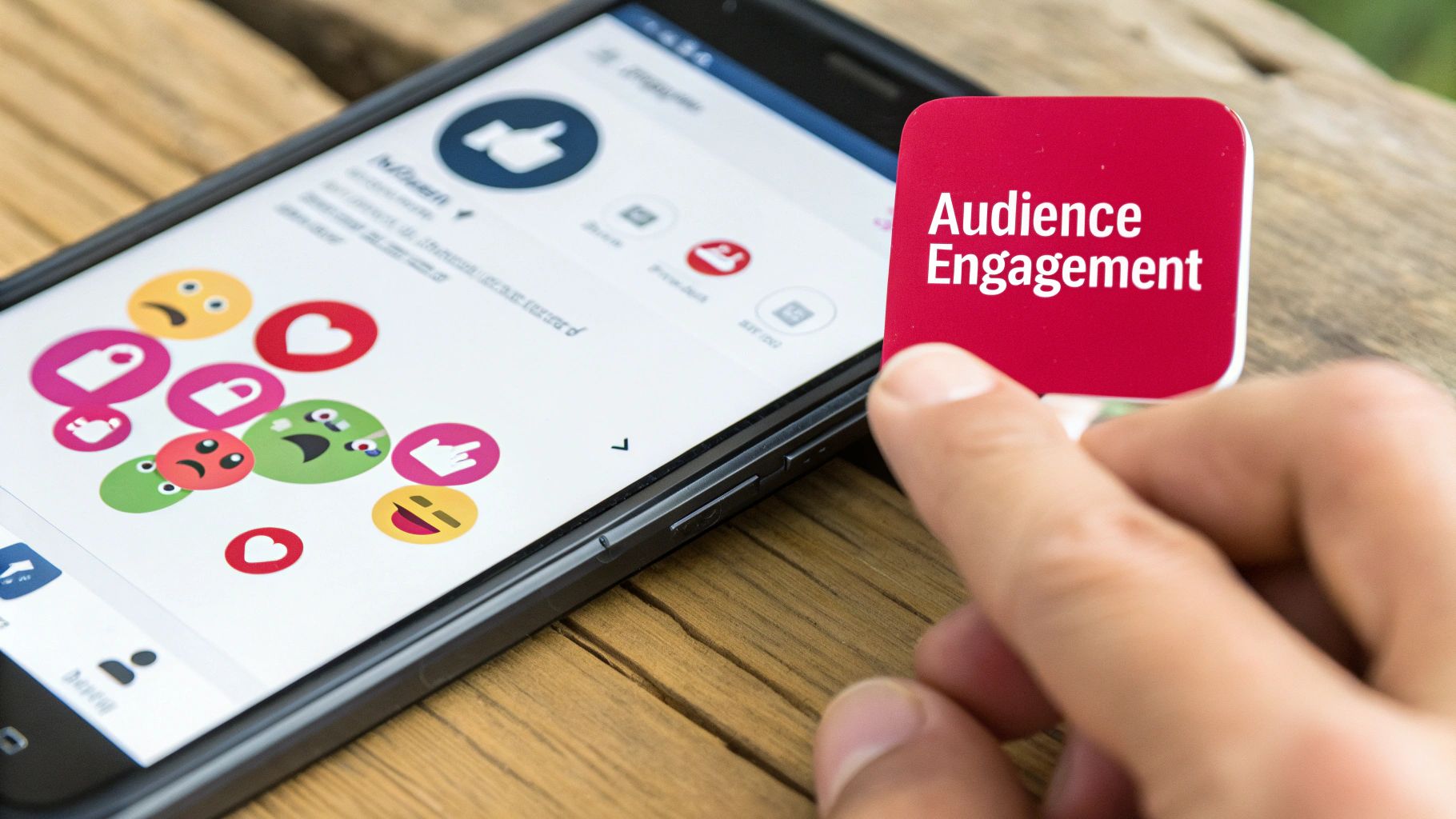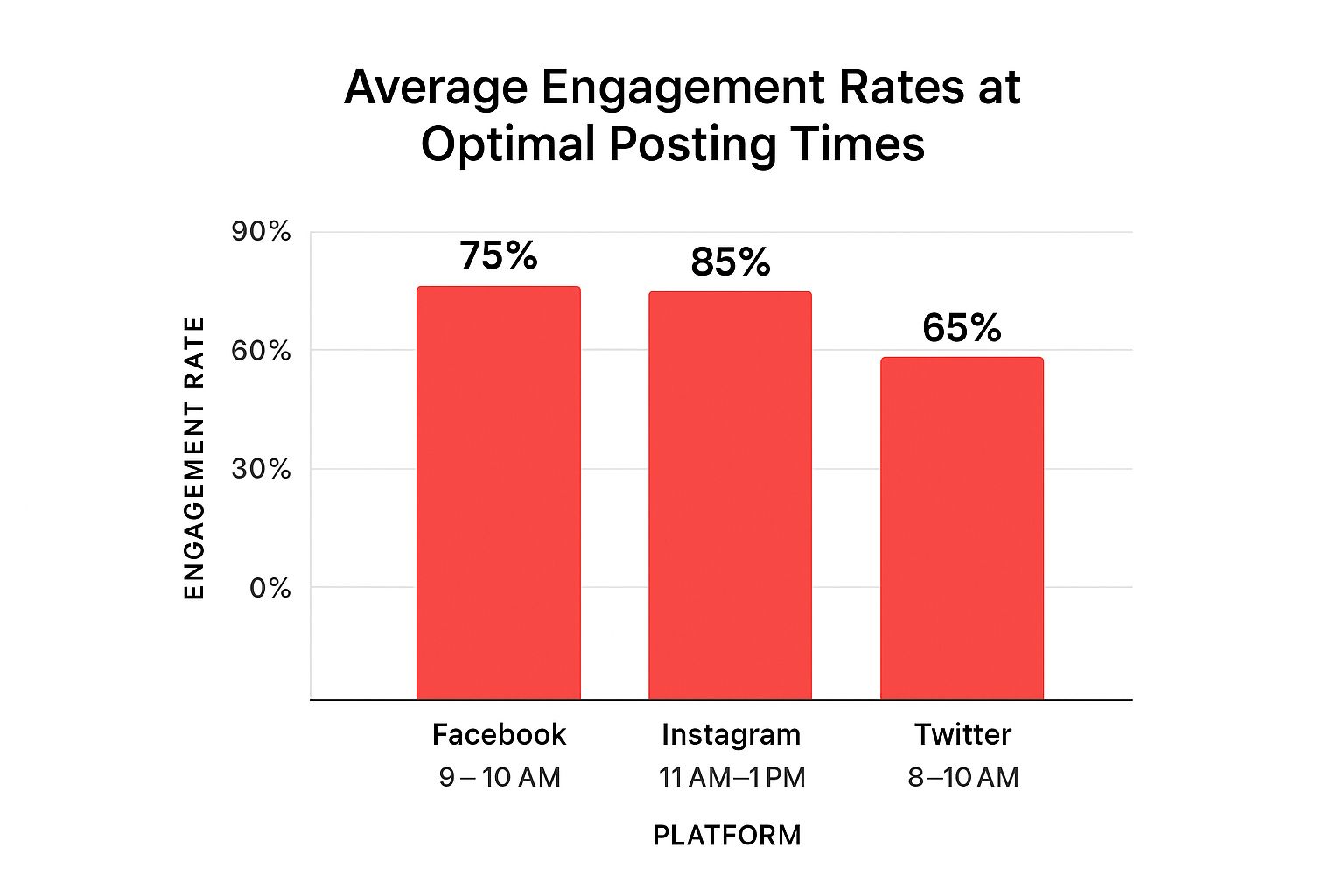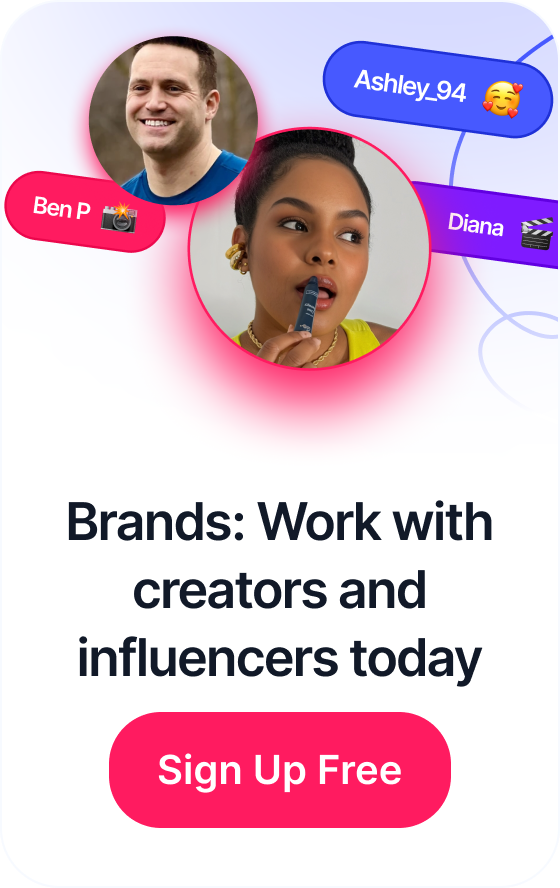 Unlocking Influence The Guide to Influencer AI
Unlocking Influence The Guide to Influencer AI
In the competitive landscape of 2025, a strong social media presence is no longer optional for small businesses; it's essential for survival and growth. With ever-changing algorithms and platforms, navigating the digital space can feel overwhelming. This guide cuts through the noise, providing proven social media marketing tips for small business owners looking to make a real, measurable impact. We will move beyond generic advice to deliver actionable strategies that build community, drive sales, and establish a memorable brand identity.
This article is designed to be a practical playbook. We will explore how to define a consistent brand voice, create compelling visual content, and engage authentically with your audience. You will learn to leverage the power of user-generated content, optimize your posting schedule for maximum reach, and make data-driven decisions using platform analytics. We'll also cover specific tactics like collaborating with micro-influencers and implementing social commerce features directly on your profiles. To truly unlock growth, consider a simplified guide to social media marketing for small business that breaks down complex strategies into actionable steps.
Whether you are just starting out or looking to refine your existing approach, these eight expert tips will provide a clear roadmap to social media success. Our goal is to help you connect with your target audience and achieve your business objectives efficiently. Let’s dive into the strategies that will transform your social channels into powerful, consistent growth engines.
Table of Contents
1. Define Your Brand Voice and Maintain Consistency
Before you post a single image or write one caption, one of the most foundational social media marketing tips for any small business is to define its brand voice. Your brand voice is the distinct personality your business adopts in all its communications. It’s not just what you say, but how you say it. This includes your tone, the language you use, and the values you represent, creating a consistent and recognizable persona that helps you connect with your audience on a human level.
A well-defined voice builds trust and familiarity. When your audience knows what to expect from your content, they are more likely to engage with it, remember your brand, and eventually become loyal customers. Consistency across all platforms, from your Instagram Stories to your LinkedIn articles, reinforces your brand identity and prevents customer confusion.

Why Brand Voice Matters
Think of iconic brands and their social media presence. Wendy's is known for its sassy, humorous, and slightly savage Twitter roasts. Innocent Drinks uses a playful, quirky, and endearingly simple tone that makes its audience smile. Both are highly effective because their voices are authentic, memorable, and flawlessly consistent. This consistency is what separates forgettable brands from those that build a dedicated community. A strong brand voice makes your business feel less like a corporation and more like a trusted friend.
How to Implement This Tip
Establishing a powerful brand voice isn't about picking a personality at random. It requires a strategic approach that aligns with your business goals and resonates with your target audience.
- Create a Brand Voice Document: This is your north star. Document key voice characteristics (e.g., "authoritative but not arrogant," "witty but not offensive"). Include a list of "words we use" and "words we avoid." As marketing thought leader Ann Handley of MarketingProfs emphasizes, documenting your voice ensures everyone on your team is on the same page.
- Audit Your Content Regularly: Set aside time each quarter to review your social media posts. Do they align with your established voice? Use this audit to identify inconsistencies and refine your guidelines.
- Train Your Team: Anyone who communicates on behalf of your brand, from social media managers to customer service reps, must understand and be able to execute the brand voice.
- Listen and Adapt: Pay attention to how your audience responds. If a certain type of humor or phrasing consistently gets high engagement, lean into it. Your voice should be firm but flexible enough to evolve with your community's preferences.
2. Create and Share High-Quality Visual Content
In today's fast-scrolling digital world, visual content is king. Posts featuring high-quality images or videos receive vastly more engagement than text-only updates, making them a non-negotiable part of any effective social media marketing strategy. This involves producing eye-catching graphics, professional photography, and compelling videos that stop users in their tracks and pull them into your brand's world.
Visuals are processed by the human brain 60,000 times faster than text, which is why a strong visual identity is crucial for capturing attention in a crowded feed. For a small business, this doesn't mean you need a Hollywood-sized budget; it means being intentional and strategic about the visual story you tell. High-quality visuals communicate professionalism, build brand recognition, and make your message more memorable and shareable.

Why Visual Content Matters
Leading brands master this art to build powerful connections. Airbnb uses stunning user-generated and professional travel photography to sell experiences, not just stays. Glossier’s minimalist, product-focused aesthetic creates a clean and aspirational feel that resonates with its target audience. These brands understand that visuals are the primary language of social media; they evoke emotion, tell a story, and drive action far more effectively than words alone. For small businesses, this is an opportunity to stand out and create a powerful first impression.
How to Implement This Tip
Elevating your visual content is an accessible goal with the right tools and approach. You can create a polished and professional look that attracts and retains followers without breaking the bank.
- Leverage User-Friendly Design Tools: You don't need to be a graphic designer. Platforms like Canva and Figma offer intuitive interfaces and thousands of templates to create professional graphics, while the Adobe Creative Suite provides more advanced capabilities as your skills grow.
- Establish a Visual Style Guide: To maintain consistency, define your brand’s color palette, typography, and logo usage. Create templates for recurring content types like quotes, promotions, or testimonials. This ensures every post feels cohesive and reinforces your brand identity.
- Invest in Good Lighting: Whether you're using a smartphone or a DSLR camera, good lighting is the single most important factor in quality photography and videography. Natural light is often best, but a simple ring light or softbox kit is an affordable investment that yields professional results.
- Optimize for Each Platform: Visuals are not one-size-fits-all. A vertical video that works perfectly for Instagram Reels will not work for a YouTube thumbnail. Always check the ideal image and video specifications for each platform to ensure your content looks its best and avoids awkward cropping.
3. Engage Actively with Your Audience
Social media is not a broadcast monologue; it's a dynamic dialogue. One of the most critical social media marketing tips for small business success is to move beyond just posting content and start actively participating in conversations. This means responding to comments, acknowledging shares, answering questions, and celebrating your followers' contributions. This two-way communication transforms your social media accounts from a static billboard into a thriving community hub where customers feel seen, heard, and valued.
Building this kind of community fosters incredible loyalty and turns passive followers into vocal brand advocates. When people see a brand taking the time to interact personally, it builds a level of trust that advertising alone cannot achieve. This active engagement creates genuine relationships, which are the bedrock of long-term customer retention and positive word-of-mouth marketing.

Why Active Engagement Matters
Think about the brands that excel at this. Taco Bell is famous for its witty, on-brand replies to customer tweets, making interactions feel personal and fun. Similarly, beauty retailer Sephora often provides personalized beauty advice directly in its comment sections, adding immense value for its followers. These brands understand that engagement is not a chore; it is an opportunity to strengthen their connection with their audience, solve problems, and showcase their brand's personality in a relatable way.
This approach demonstrates that you care about your customers beyond the transaction. It shows that there are real people behind the logo who are listening and are invested in the customer experience.
How to Implement This Tip
Effectively engaging with your audience requires a proactive and organized strategy. It's about being present and responsive in the moments that matter most to your followers.
- Be Responsive and Timely: Aim to respond to comments and direct messages as quickly as possible, ideally within a few hours during business hours. Use platform tools to set up notifications for mentions and comments so you never miss an interaction.
- Ask Open-Ended Questions: Don't just talk at your audience; talk with them. End your captions with questions that encourage thoughtful responses and spark conversations among your followers.
- Embrace User-Generated Content (UGC): When a customer tags your business in a post, share it! Celebrating customer content is a powerful form of social proof and makes your community feel recognized and appreciated. Always ask for permission before reposting.
- Use Social Listening Tools: Go beyond direct mentions. Use tools to monitor conversations about your brand, industry, and competitors. This allows you to join relevant discussions and engage with potential customers who may not be following you yet. For a deeper dive into boosting these interactions, you can explore how to increase social media engagement on joinbrands.com.
4. Leverage User-Generated Content (UGC)
One of the most powerful and cost-effective social media marketing tips for any small business is to leverage user-generated content (UGC). This strategy involves encouraging your customers to create and share content, like photos, videos, and reviews, that features your brand or products. UGC acts as authentic social proof, harnessing genuine customer experiences to build credibility, expand your reach, and create a rich library of marketing assets without a huge budget.
When potential customers see real people enjoying your products, it builds a level of trust that branded advertising simply cannot replicate. It transforms your audience from passive consumers into active brand advocates. This approach fosters a strong sense of community, making customers feel valued and seen, which in turn strengthens their loyalty and encourages repeat business.
Why UGC Matters
Think about the most memorable brand campaigns. GoPro built its entire marketing empire on breathtaking adventure videos shot by its customers. Similarly, Coca-Cola's #ShareACoke campaign invited people to find and share photos with personalized bottles, creating a massive, global conversation driven entirely by its audience. This content feels more genuine and trustworthy because it comes from a peer, not the company.
UGC effectively outsources your content creation to your most passionate fans. It provides a constant stream of fresh, diverse, and relatable material that resonates deeply with your target audience, making your brand more approachable and human.
How to Implement This Tip
Successfully encouraging and curating UGC requires a clear and proactive strategy. It’s about creating an environment where customers feel excited and motivated to share their experiences with your brand.
- Create a Branded Hashtag: Develop a unique, memorable, and easy-to-spell hashtag for your campaign or brand (e.g., #RedCupContest for Starbucks). Promote it everywhere: in your social media bios, on your packaging, and in-store.
- Offer Incentives: Motivate participation by running contests, offering discounts, or simply featuring the best submissions on your page. A small reward can lead to a significant increase in high-quality content.
- Always Ask for Permission: Before reposting a customer's content, always ask for their explicit permission and be sure to credit them properly in your caption. This shows respect for their work and protects your business legally.
- Set Clear Guidelines: To ensure the content aligns with your brand values, provide simple guidelines for what you're looking for. This helps manage expectations and improves the quality of submissions. To dive deeper, you can learn more about building a successful user-generated content strategy on joinbrands.com.
5. Optimize Posting Times and Frequency
Posting great content is only half the battle; ensuring it reaches your audience at the right moment is just as crucial. One of the most impactful social media marketing tips for small business owners is to optimize posting times and frequency. This strategic approach involves publishing content when your target audience is most active and receptive, which significantly boosts visibility, engagement, and the overall effectiveness of your campaigns.
Simply posting whenever you have a free moment means your content might get buried in crowded feeds before your ideal customers even have a chance to see it. By analyzing audience behavior and platform-specific trends, you can schedule your posts for maximum impact. This ensures your hard work gets the attention it deserves, leading to higher reach, more likes, comments, shares, and ultimately, better conversion rates.
The bar chart below illustrates how average engagement rates can peak at different times across major social media platforms, highlighting the importance of a tailored scheduling strategy.

This data shows that a one-size-fits-all approach to scheduling is ineffective, as user activity on Instagram surges midday while Twitter and Facebook engagement is higher in the morning.
Why Posting Times Matter
Every social media platform has its own rhythm, dictated by user behavior and algorithms. A B2B company might find its LinkedIn audience is most engaged during weekday business hours (9 AM to 12 PM), while a local restaurant could see a spike in Instagram engagement right before lunch (11 AM) and dinner (6 PM). Posting at these optimal times means your content appears at the top of feeds when users are actively scrolling, making them far more likely to interact with it.
Consistent frequency is also key. Posting too little can cause your brand to be forgotten, while posting too much can annoy your followers and lead to unfollows. A steady, predictable cadence, such as 1-2 high-quality posts per day, keeps your audience engaged without overwhelming them. It signals to platform algorithms that your account is active and valuable, which can improve your organic reach over time.
How to Implement This Tip
Finding your unique sweet spot for posting requires data analysis, experimentation, and a deep understanding of your audience’s daily routines.
- Dive Into Your Analytics: Every major social media platform has a built-in analytics tool (like Instagram Insights or Facebook Page Insights). Use these to identify the specific days and hours when your followers are most active online. This data is the best starting point for creating your initial posting schedule.
- Use a Scheduling Tool: Manually posting at optimal times isn’t always feasible. Tools like Buffer, Hootsuite, or Sprout Social allow you to schedule your content in advance, ensuring you never miss a peak engagement window. This consistency is a cornerstone of an effective social media strategy.
- Test and Measure: Don't just set your schedule and forget it. Experiment by posting at different times outside of the recommended windows and meticulously track the results. You might discover a unique time slot where your content performs exceptionally well because there is less competition.
- Consider Your Audience's Lifestyle: Think about your ideal customer's daily routine. A fitness brand might post workout motivation early in the morning, while an entertainment brand could schedule posts for evening leisure hours when people are relaxing. Align your content with these lifestyle patterns to maximize relevance.
6. Use Social Media Analytics and Data-Driven Decisions
Posting content without analyzing its performance is like driving with your eyes closed. One of the most critical social media marketing tips for small business growth is to use analytics to make data-driven decisions. This involves systematically tracking, measuring, and analyzing key performance metrics to understand what content resonates, who your audience is, and how to refine your strategy for maximum impact.
A data-driven approach transforms your social media from a guessing game into a predictable engine for growth. By understanding the numbers behind your posts, you can stop wasting time on content that doesn't work and double down on what truly drives engagement and conversions. This ensures your limited resources are invested where they will generate the highest return.
Why Data-Driven Decisions Matter
Analytics reveal the story behind your audience's behavior. For example, Instagram Insights might show that your behind-the-scenes Stories get twice the engagement of your polished product shots, or Google Analytics might reveal that LinkedIn is your top source of website traffic that converts into sales. This isn't just data; it's a roadmap to success. Brands that harness this information can pivot quickly, optimize campaigns in real-time, and build a more effective marketing funnel. Without analytics, your strategy is based on assumptions, which is a risky bet for any small business.
How to Implement This Tip
Shifting to a data-first mindset requires setting up processes to consistently gather and interpret information. It’s about creating a feedback loop where performance data directly informs your next move.
- Focus on Business-Aligned Metrics: Don't get lost in vanity metrics like follower count. Instead, focus on data that impacts your bottom line, such as click-through rates, conversion rates, and cost per acquisition. Set up conversion tracking to see how social media activity translates into website sales or leads.
- Establish a Reporting Cadence: Review your analytics weekly to spot short-term trends and create a more comprehensive report monthly to track long-term progress against your goals. Use tools like Hootsuite or Sprout Social for detailed reports or the native analytics on each platform.
- A/B Test Your Content: Use data to test variables. Pit two different captions, images, or call-to-actions against each other to see which performs better. This eliminates guesswork and continually refines your approach.
- Audit Your Ad Performance: To truly make data-driven decisions with paid social, small businesses should regularly audit their advertising performance. For instance, you could utilize a service offering a free ad account audit to gain expert insights into campaign efficiency and uncover opportunities for improvement.
7. Collaborate with Micro-Influencers and Local Partners
Instead of chasing celebrity endorsements with massive price tags, one of the most effective social media marketing tips for a small business is to partner with micro-influencers and local figures. Micro-influencers, typically with follower counts between 1,000 and 100,000, often boast higher engagement rates and a more dedicated, niche audience. These partnerships provide authentic social proof and targeted reach without breaking the bank.
This strategy is powerful because it leverages trust that has already been established. A recommendation from a smaller, more relatable creator often feels more like a genuine suggestion from a friend than a paid advertisement. For businesses targeting a specific geographic area, collaborating with local partners like community leaders or complementary businesses can amplify your brand presence and embed you directly into the local conversation.
Why Micro-Influencers Matter
The power of micro-influencers lies in their authenticity and niche authority. A local fitness studio partnering with a neighborhood wellness blogger or a small-batch coffee roaster collaborating with a local food influencer creates a highly relevant and credible endorsement. These creators have built genuine connections with their followers, who trust their recommendations implicitly. This translates to higher-quality engagement and a better return on investment compared to macro-influencer campaigns.
As marketing expert Jay Baer notes, "True influence is not about the size of your audience, but the action it takes." Micro-influencers excel at driving action because their audience is not just watching; they are listening and engaging on a deeper level.
How to Implement This Tip
Successful influencer collaborations are built on strategy, not just sending free products into the void. A structured approach ensures both you and your partner benefit from the relationship.
- Prioritize Engagement Over Followers: Look for influencers with a high engagement rate (likes, comments, shares) relative to their follower count. This indicates an active and loyal community. Use tools to analyze their audience demographics and authenticity.
- Define Clear Expectations: Create a simple collaboration agreement outlining deliverables, timelines, messaging points, and compensation (whether it's payment, product exchange, or a commission). This prevents misunderstandings and ensures a professional partnership. To get started, you can find valuable insights on how to collaborate with influencers on joinbrands.com.
- Focus on Local Synergies: Don't overlook partnerships with other local small businesses. A joint giveaway, a co-hosted event, or a cross-promotional social media campaign can introduce your brand to a new, highly relevant local audience.
- Track Your Results: Provide partners with unique discount codes or trackable links (like UTM parameters) to measure the direct impact of their campaigns. This data will help you identify your most valuable partners and refine your future collaboration strategy.
8. Implement Social Commerce Features
Social media has evolved from a place of connection to a powerful engine for commerce. One of the most impactful social media marketing tips for any small business with products is to implement social commerce features. This means integrating shopping capabilities directly into your social media profiles, allowing users to discover, browse, and purchase products without ever leaving the app. This creates a seamless, low-friction path from inspiration to conversion.
By removing extra steps like clicking a link in bio or navigating a separate website, you shorten the customer journey and capture sales at the peak of a buyer's interest. This direct integration transforms your social media pages from simple marketing channels into fully-functional digital storefronts, boosting both user experience and revenue.
Why Social Commerce Matters
The modern consumer values convenience above all else. Social commerce meets this demand by making the shopping experience immediate and intuitive. For example, a follower can see a dress they love in an Instagram post, tap a product tag to see its price, and proceed to checkout in just a few clicks. This immediacy significantly reduces cart abandonment and capitalizes on impulse-buy behavior.
Platforms like Instagram and Facebook have invested heavily in these features, signaling a major shift in online retail. Small businesses that adopt social commerce can level the playing field, competing with larger brands by offering an equally streamlined and engaging shopping experience directly where their audience spends their time. It turns passive scrolling into active shopping.
How to Implement This Tip
Integrating e-commerce into your social media strategy is more accessible than ever. It requires a thoughtful approach to product presentation and a commitment to customer engagement directly on the platform.
- Set Up Your Shops: Connect your product catalog to platforms like Facebook Shop, Instagram Shopping, and Pinterest. Many e-commerce platforms like Shopify and BigCommerce offer direct integrations that make this process straightforward and sync inventory automatically.
- Optimize Product Visuals and Descriptions: Your product photos and videos must be high-quality and formatted for mobile viewing. Write compelling, concise descriptions that highlight key benefits and use relevant keywords, just as you would on your website.
- Use Shoppable Tags Consistently: Tag products in all relevant content, including feed posts, Stories, Reels, and even live streams. This makes every piece of content a potential sales opportunity and trains your audience to look for shoppable items.
- Promote Shoppable Content: Boost high-performing shoppable posts with paid advertising to reach a wider, targeted audience. Create ad campaigns specifically designed to drive traffic to your social storefronts and increase direct conversions.
8 Key Social Media Marketing Tips Comparison
| Strategy | 🔄 Implementation Complexity | 🛠️ Resource Requirements | 📊 Expected Outcomes | 💡 Ideal Use Cases | ⭐ Key Advantages |
|---|---|---|---|---|---|
| Define Your Brand Voice and Maintain Consistency | Medium (Requires time & ongoing monitoring) | Moderate (Team training & guidelines creation) | Strong brand recognition and trust | Brands aiming for distinct, consistent messaging | Builds loyalty, differentiates, improves engagement |
| Create and Share High-Quality Visual Content | High (Design skills & platform specs) | High (Design tools, equipment, or budget) | Increased engagement (up to 650% more) | Visual-centric brands or campaigns | Boosts professionalism, shareability, and reach |
| Engage Actively with Your Audience | High (Real-time responses & moderation) | High (Dedicated team/time for engagement) | Stronger relationships and brand loyalty | Brands focused on community building | Improves visibility, insights, and word-of-mouth |
| Leverage User-Generated Content (UGC) | Medium (Campaign management & content curation) | Moderate (Incentives, monitoring, permissions) | Authentic social proof, expanded reach | Brands wanting authentic content and trust | Cost-effective, boosts loyalty, higher conversion |
| Optimize Posting Times and Frequency | Medium (Ongoing analysis & scheduling) | Moderate (Analytics tools & planning time) | Maximized reach and content visibility | Brands aiming to refine posting strategy | Better ROI, consistent audience engagement |
| Use Social Media Analytics and Data-Driven Decisions | Medium-High (Data collection & interpretation) | Moderate-High (Multiple analytics tools/time) | Informed decisions and optimized strategy | Data-driven brands focused on growth | Identifies trends, optimizes budget, measures ROI |
| Collaborate with Micro-Influencers and Local Partners | Medium (Influencer vetting & relationship mgmt) | Moderate (Compensation or product exchange) | Higher engagement and targeted reach | Small businesses targeting niche or local markets | Affordable, authentic endorsements, niche targeting |
| Implement Social Commerce Features | High (Platform integration & policy compliance) | Moderate-High (Tech setup & management) | Increased conversions and seamless shopping | E-commerce brands looking for frictionless sales | Reduces purchase friction, integrates marketing & sales |
Putting Your Social Media Plan into Action
The journey through the dynamic landscape of social media marketing is not about finding a single magic bullet, but about building a cohesive, adaptable machine. We've explored eight foundational social media marketing tips for small business, each serving as a critical gear in this machine. From establishing an unwavering brand voice to harnessing the power of high-quality visuals, the goal is to create a consistent and recognizable presence that resonates with your ideal customer.
Remember, social media is a two-way street. The tips on active audience engagement and leveraging user-generated content (UGC) are not just tactics; they are philosophies centered on community building. Your audience wants to be seen and heard, and by making them the hero of your story, you transform passive followers into passionate brand advocates. This authentic connection is the most defensible moat any small business can build.
From Insights to Impact
Data should be the bedrock of your strategy. Relying on gut feelings is a recipe for wasted resources. The principles of optimizing post times and diving deep into social media analytics are what separate stagnant accounts from those that experience exponential growth. These data-driven decisions inform every other aspect of your plan, telling you what content works, who it works for, and when they want to see it. It’s the feedback loop that fuels continuous improvement and ensures your efforts are translating into tangible business outcomes.
Strategic partnerships also offer a powerful lever for growth. Collaborating with micro-influencers and implementing social commerce features are not just about reaching new audiences; they are about meeting modern consumers where they are. These strategies build trust through third-party validation and reduce friction in the buying process, directly impacting your bottom line. Each of these pillars works in concert: a strong brand voice makes influencer partnerships more effective, and great analytics help you identify which social commerce features are driving the most sales.
Your Actionable Next Steps
Feeling overwhelmed is a natural reaction to the sheer volume of possibilities. The key is to start small and build momentum. Don't try to implement all eight strategies at once. Instead, choose one or two areas that represent the biggest opportunity for your business right now.
Here is a simple framework to get you started:
- Conduct a Quick Audit: Review your current social media presence. Where are the most significant gaps based on the tips we've covered? Is your brand voice inconsistent? Is your engagement low?
- Select Your Focus Areas: Pick two tips to prioritize for the next 90 days. For example, you might focus on 'Engage Actively with Your Audience' and 'Leverage User-Generated Content (UGC)'.
- Set Measurable Goals: Define what success looks like. For engagement, it might be a 20% increase in comments. For UGC, it could be securing 10 pieces of high-quality customer content to share.
- Execute and Measure: Implement the specific, actionable tactics associated with your chosen tips. Track your progress weekly and review your goals monthly.
By breaking down the process into manageable, focused sprints, you can make steady, measurable progress. Mastering these social media marketing tips for small business is an iterative process of learning, testing, and refining. The most successful brands are not the ones that get it perfect from day one, but the ones that commit to consistent effort and data-informed adaptation. Your path to creating a thriving online community and driving sustainable growth starts not tomorrow, but with the very next post you create.
Ready to supercharge your content strategy and unlock authentic growth? JoinBrands connects you with a global network of vetted creators to produce stunning user-generated content and manage impactful influencer campaigns at scale. Elevate your social media presence by visiting JoinBrands and discover how easy it is to source high-quality, on-brand content that converts.








